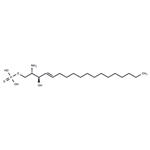Sphingosine-1-phosphate (S1P) is the product of phosphorylation of sphingosine by sphingosine kinase that is secreted from cells and acts as an agonist at S1P receptors. It increases intracellular calcium levels in TAg-Jurkat cells expressing S1P1 and Gqi5, which allows for phospholipase C stimulation by Gi proteins, when used at a concentration of 200 nM, as well as in TAg-Jurkat cells expressing S1P2 and S1P3 receptors (EC50s = 8 and 11 nM, respectively). Intra- and extracellular levels of S1P vary spatially allowing it to function as an autocrine or paracrine factor, respectively, and dysregulation of S1P levels are associated with various disease states, such as inflammation and autoimmunity. S1P has a wide variety of effects, including an involvement in cell growth, angiogenesis, immunity, and neuroprotection.
D-erythro-Dihydrosphingosine-1-phosphate is a saturated analog of D-erythro-Sphingosine-1-phosphate a putative lipid second messenger; found to inhibit cellular mobility of melanoma cells at very low concentrations with no toxic effects thereby making it a possible agent for prevention of tumor cell metastasis and inflammatory processes.
A putative lipid second messenger; found to inhibit cellular mobility of melanoma cells at very low concentrations with no toxic effects thereby making it a possible agent for prevention of tumor cell metastasis and inflammatory processes. It mobilizes intracellular calcium stores, decreases cellular cAMP, activates phospholipase D and does not inhibitprotein kinase C.
A ligand for EDG-1 and EDG-3 and activator of GPR3, GPR6, and GPR12.
ChEBI: A phosphosphingolipid that consists of sphingosine having a phospho group attached at position 1
Sphingosine-1-phosphate (S1P), a sphingolipid, is an important cellular metabolite and signaling lipid in animal cells. It has also been found in yeasts and plants. Sphingosine kinases (SPKs) catalyzes the synthesis of S1P from spingosine and regulates S1P levels. It is the end product of ceramide catabolism and is metabolized to phosphoethanolamine and hexadecenal by S1P lyase. S1P is produced in endothelial cells.
Endogenous second messenger involved in the control of cell proliferation and motility, and Ca 2+ mobilization. Acts as an agonist at sphingosine-1-phosphate receptors, S1P 1-5 . Effectors regulated include p38 MAP kinase, PLC, adenylyl cyclase, myosin light chain phosphatase and focal adhesion kinase.
A lipid second messenger that binds to S1P1 and S1P3 receptors. Mobilizes intracellular Ca2+ stores and decreases cellular cAMP. Activates phospholipase D. S1P stimulates the migration of endothelial cells but inhibits the migration of other cell types. Induces angiogenesis.
1) Spiegel and Milstien (2003)?Sphingosine-1-phosphate: an enigmatic signaling lipid; Nat. Rev. Mol. Cell Biol.,?4?397
2) Rosen?et al. (2009)?Sphingosine-1-phosphate receptor signaling; Annu. Rev .Biochem.,?78?743
3) Maceyka?et al. (2012)?Sphingosine-1-phosphate signaling and its role in disease; Trends Cell Biol.,?22?50


